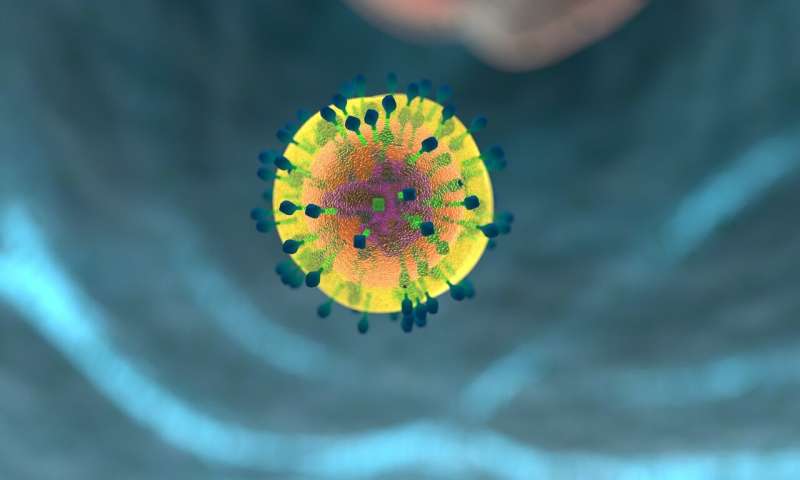This article has been reviewed according to Science X's editorial process and policies. Editors have highlighted the following attributes while ensuring the content's credibility:
fact-checked
peer-reviewed publication
trusted source
proofread
Combo immunotherapy produces distinct waves of cancer-fighting T cells with each dose

A new tool for monitoring immune health patterns over time has revealed how a pair of checkpoint inhibitor therapies works together to recruit new cancer-fighting T cells with every infusion.
Findings on the use of the new tool, developed by researchers at the University of Pennsylvania Perelman School of Medicine and Penn Medicine's Abramson Cancer Center (ACC), were published in Cancer Cell.
The study challenges fundamental assumptions about how a common immunotherapy drug combination activates different types of T cells to defeat cancer and could help researchers more precisely measure immune response in future clinical trials.
Immunotherapy has made immense progress in improving survival for advanced melanoma over the last decade, although researchers are still working to understand why some patients' cancers respond better than others and to develop therapies that come with less side effects. This study focused on a particular immunotherapy combination that has become a mainstay of melanoma treatment: PD-1 and CTLA-4 checkpoint inhibitors.
A new understanding of T cell response
Immune checkpoint inhibitors work by unleashing T cells to find and kill cancer cells. It was thought that this type of combination immunotherapy works by equipping an army of T cells to recognize and fight cancer throughout the course of treatment.
In a sense, the idea was that if this group of T cells stayed strong for long enough, they would conquer cancer, but if they became too depleted, they would lose the battle.
The study, which analyzed data from 36 patients treated with immunotherapy for advanced melanoma, found that the combination therapy produces waves of new T cells—known as a clonal response—with each dose, rather than continually strengthening the same pool of T cells.
"We found that after every infusion, you have a new immune response, with a new group of T cells coming in to fight the cancer," explained senior author Alexander Huang, MD, an assistant professor of Hematology-Oncology and a research investigator with the Tara Miller Melanoma Center at the ACC.
"Think about these T cells like an army: for many cancer patients, even when they have tumors growing, experienced T cell fighters are trying to slow down the advance of the enemy cancer cells. We call them 'exhausted T cells' because they've been fighting so long, but they're elite because they're able to survive in a hostile environment and know how to recognize and fight the cancer cells."
Conventional thought was that certain immune checkpoint blockade therapies would strengthen exhausted T cells, directly rejuvenating them. However, these new data suggest that immune checkpoint blockade actually brings in new recruits from the barracks to fight the cancer.
Conversely, there comes a time when the new T cell recruits have all been sent out and the barracks are empty, and this is when immune checkpoint blockade may become less effective.
Previous research has shown that exhausted T cells, the elite fighters, come from a source called progenitor cells. Anti-PD-1 immunotherapy taps into this source and eventually depletes the supply. In the current study, the researchers discovered that anti-CTLA-4 therapy complements PD-1 checkpoint inhibitors by replenishing the supply of progenitor-exhausted T cells, adding more elite fighters to the ranks.
Evaluating immune response over time
To make these discoveries, the team developed a new algorithm called Cyclone to track immune response and patterns over time by following the unique receptors from individual T cells.
Looking at blood samples from the same patients, taken during different points throughout their treatment, the researchers were able to see which T cells moved, remained, or disappeared over each patients' nine-week course of treatment.
This approach also allows researchers to evaluate the magnitude of response, including how many and what type of immune cells are being activated over time as patients go through treatment. Comparatively, other current single-cell methods of studying immune response provide more of a narrow "snapshot" in time.
"We envision that this more precise method of immune monitoring could be applied to clinical trials in several ways," Huang said.
"For example, it could help researchers better understand how new drugs are impacting the immune system or understand the appropriate dosage needed to produce the necessary biological effect, without having to push to find the 'maximum tolerated dose' and potentially expose patients to unnecessary toxicity."
The research team is planning to apply Cyclone in upcoming clinical trials for new cancer immunotherapy approaches, including neoadjuvant studies where T cells can be tracked in both blood and tumor samples, and new immunotherapy combinations, such as drugs targeting PD-1 and LAG-3, a new type of checkpoint inhibitor therapy.
The lead author of the study was Kevin Wang, a medical student in Huang's laboratory.
More information: Combination anti-PD-1 and anti-CTLA-4 therapy generates waves of clonal responses that include progenitor-exhausted CD8+ T cells, Cancer Cell (2024). DOI: 10.1016/j.ccell.2024.08.007. www.cell.com/cancer-cell/fullt … 1535-6108(24)00306-4


















